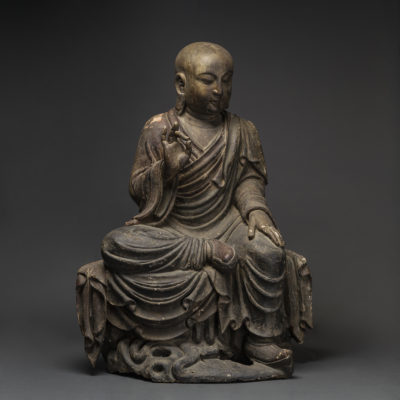
| SKU | X.0704 |
|---|---|
| Circa | 15th Century AD to 17th Century AD |
| Medium | Wood |
| Origin | China |
| Gallery Location | S Korea |
This imposing Luohan figure dates from the dynamic period surrounding the second half then collapse of the Ming Dynasty, and the rise of the Qing. This period spans the 15th to 17th centuries AD, and saw many of the most important developments in Chinese culture. The Ming, founded in 1368 under the peasant emperor Hong Wu, was a militarily oriented socio-political entity much given to radical interpretations of Confucianism and with a very strong defensive ethos (much of the Great Wall dates to this period). However by the 17th century cracks had started to appear, young male heirs being manipulated as puppets by the ruling families, and the court became rotten with intrigue. To compound matters, the Manchurian Chinese cities were being attacked by local groups dubbed the Manchus who eventually invaded China and deposed the old regime. The last Ming emperor, Chongzhen, hanged himself on Coal Hill overlooking the Forbidden City, bringing an end to his line and ushering in the Qing dynasty. The Qing was founded by Nurhaci in the early 17th century, and persisted until the collapse of imperial China in 1912 with the hapless Pu-Yi, the last emperor of China. Their isolationist policies, social control (all men required to shave their heads, wear queues, and wear Manchu rather than traditional Chinese dress) introspection and cultural conservatism was at odds with their liberality in certain social issues such as forbidding the binding of womens feet (later withdrawn due to social pressure from the populace). However, this cultural inflexibility which grew as the emperors grew increasingly unaware of the world outside their palace walls, much less the countrys borders was a difficult stance to maintain in the shadow of the European thalassocracies, and it may have been this which helped hasten the demise of the Imperial system. The Ming and the Qing dynasties were highly creative times, seeing the appearance of the first novels written in the vernacular, considerable development in the visual arts and outstanding craftsmanship in all fields. The present sculpture is a case in fact, and it is perhaps somewhat disarming to reflect that this peaceful figure dates from a period of such spectacular turmoil. In Theravada Buddhism, the Arhat, Arahat or Arahant (translated into Chinese as Luohan) is one who has followed the Eightfold Path and has achieved deliverance of this earthly existence. He has reached “the other shore” and is saved for all eternity. In him the asavas ignorance, earthly existence and the craving for sensual pleasures are absent. He is subject to no more rebirths and karma. Luohans are renowned for their great wisdom, courage and supernatural power. Due to their abilities to ward off the evil, Luohans have became guardian angels of the Buddhist temple and there in the main hall standing guard are the ever-present, indomitable-looking 18 Luohan figures, sometimes accompanied by 500 or more lesser Luohans. The present example depicts the seated figure of a Buddhist saint or possibly the youngest of Sakiamuni’s disciples, Ananda, resting on a rock pedestal. The figure is of a well-nourished man of mature years, with a glabrous, polished head and elongated earlobes hanging almost to shoulder level. He is dressed in a long tunic with very well carved drapery, one leg bent inward on the stand, the other pointing down. The right hand is raised in vitarka (teaching) mudra, the other rested almost casually on the left leg. The figure has a beautiful, dark patina that perfectly complements its stately yet slightly louche demeanour. This is a charming and amusing figure in good condition, and would be an excellent addition to any collection.
Login to view price
Sign-up to receive the latest Wedding Estates news and promotions!

